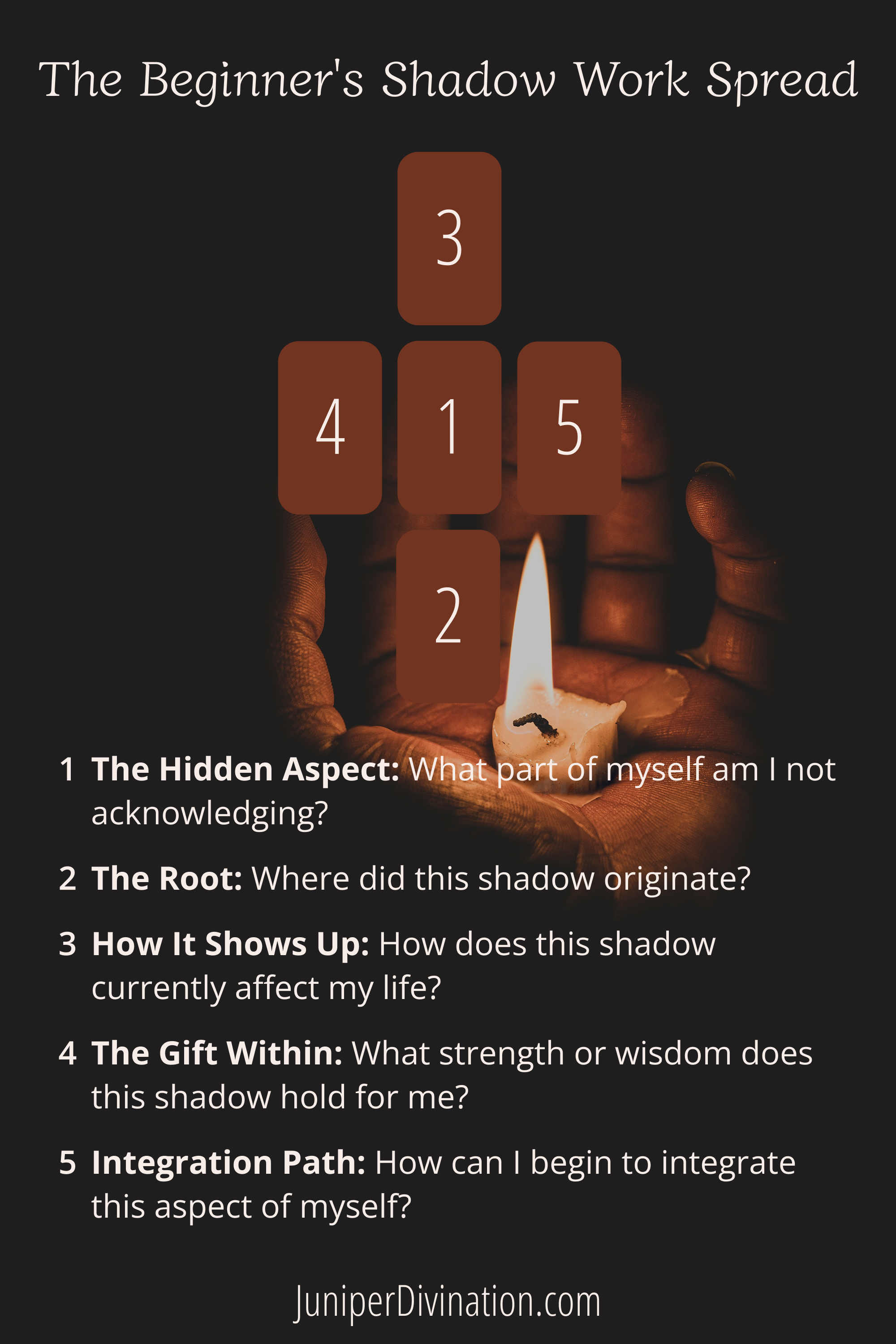
The Beginner's Shadow Work Tarot Spread - A Gentle Introduction to Self-Discovery
Shadow work tarot offers a practical way to explore the parts of yourself you might not readily acknowledge—your hidden strengths, unexamined patterns, and rejected qualities. This beginner-friendly spread helps you approach shadow work with curiosity rather than fear, using tarot as a mirror for self-reflection.
What Is Shadow Work?
Shadow work involves examining the aspects of yourself that you’ve pushed aside or hidden from conscious awareness. These “shadow” elements aren’t inherently negative—they include forgotten strengths, suppressed creativity, and adaptive behaviors that no longer serve you. Shadow work tarot for beginners provides structure for this exploration, making it accessible without requiring years of psychological training.
About This Spread
The Beginner’s Shadow Work Spread uses five cards to gently guide you through recognizing, understanding, and integrating a shadow aspect. It’s designed specifically for those new to shadow work, focusing on one element at a time rather than overwhelming you with deep psychological excavation.
How to Use This Shadow Work Tarot Spread
Before you begin:
- Choose a quiet time when you won’t be interrupted
- Have a journal nearby for reflection
- Approach the reading with curiosity, not judgment
- Remember: shadow work isn’t about fixing yourself—it’s about understanding yourself
The Reading Process:
- Shuffle your deck while focusing on the intention: “What shadow aspect is ready to be acknowledged?”
- Draw five cards and place them according to the layout
- Take time with each position—shadow work tarot readings work best when you sit with uncomfortable insights rather than rushing through them
- Write down your immediate reactions before analyzing the cards
- Return to your reading after a day or two; shadow insights often deepen with time
The Five Positions Explained
Position 1: The Hidden Aspect
What part of myself am I not acknowledging?
This card reveals the shadow element seeking your attention. It might show a trait you’ve dismissed, a need you’ve ignored, or a pattern you’ve rationalized away.
Journal Prompts:
- When have I noticed this quality in others and felt strongly about it?
- What would it mean if I possessed this trait?
- How might denying this aspect be limiting me?
Position 2: The Root
Where did this shadow originate?
This position explores the conditions that created your shadow. Often, we hide parts of ourselves because they were once unsafe to express or contradicted messages we received about who we should be.
Journal Prompts:
- What early experiences taught me to hide this part of myself?
- Who in my life couldn’t accept this quality?
- What did I believe would happen if I showed this aspect?
Position 3: How It Shows Up
How does this shadow currently affect my life?
Your shadow doesn’t disappear when hidden—it influences your choices, relationships, and self-perception. This card illuminates how the unacknowledged aspect manifests in your daily life.
Journal Prompts:
- Where do I see this pattern repeating in my life?
- How might this shadow be affecting my relationships?
- What opportunities have I avoided because of this hidden aspect?
Position 4: The Gift Within
What strength or wisdom does this shadow hold for me?
Every shadow contains something valuable. This is the most important position in shadow work tarot for beginners—it reframes shadow work from “fixing problems” to “reclaiming lost parts.”
Journal Prompts:
- What positive qualities connect to this shadow aspect?
- How might integrating this element improve my life?
- What becomes possible when I acknowledge this part of myself?
Position 5: Integration Path
How can I begin to integrate this aspect of myself?
This card offers practical guidance for bringing your shadow into consciousness. Integration doesn’t mean dramatic personality changes—it means acknowledging what’s already there.
Journal Prompts:
- What small step could I take to honor this aspect?
- Who in my life already accepts this part of me?
- How can I practice expressing this quality safely?
Tips for Beginners
Start small. You don’t need to tackle your deepest wounds in your first shadow work tarot reading. This spread works beautifully for examining everyday patterns.
Trust unclear answers. Shadow material resists clear interpretation by nature. If a card confuses you, that confusion is data—it shows where your awareness has limits.
Track patterns over time. Use this spread monthly. You’ll notice how certain themes recur, giving you a roadmap for deeper work.
Integrate before excavating more. Give yourself time to work with insights from one reading before pulling cards on another shadow aspect.
Continue your practice. Shadow work is most effective when you explore different angles over time. Grab 11 more shadow work spreads from my shop to deepen your self-discovery practice with varied approaches to integration, healing, and growth.
Moving Forward
Shadow work tarot transforms self-awareness from abstract concept to actionable practice. This beginner-friendly spread provides structure without rigidity, allowing you to explore at your own pace. Remember: shadow work is a practice, not a project. Each reading builds your capacity for self-honesty and integration.
